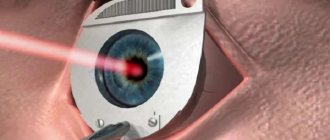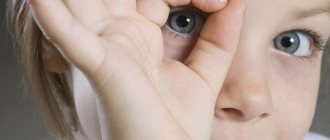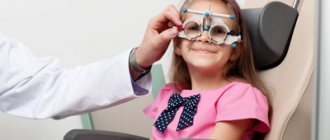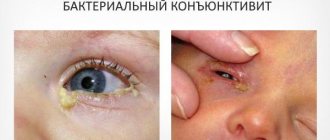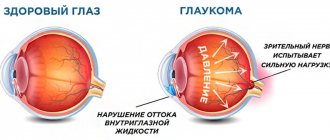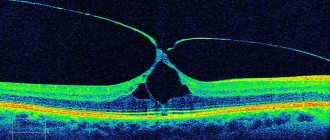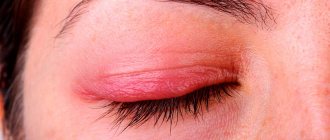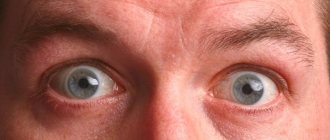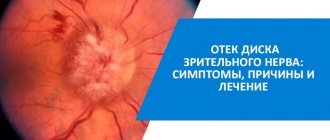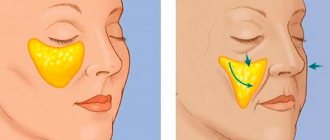The eyes are the most highly developed sensory organs of the body. In fact, a much larger portion of the brain is devoted to vision rather than hearing, taste, touch, or smell combined! We tend to take vision for granted. But when vision problems arise, most of us will do everything in our power to restore normal vision.
The most common forms of vision impairment are refractive errors —the way light rays are focused inside the eye so that images can be transmitted to the brain. Nearsightedness, farsightedness, and astigmatism are examples of refractive errors.
Refractive errors can be corrected usually with glasses, contact lenses, or refractive surgery such as LASIK. Other vision problems may be related to an eye disease. Retinal detachment, macular degeneration, cataracts and glaucoma are problems with the function of the eye and its processing units. These problems can lead to blurry or defective vision.
Treatment goals vary by disease and may include restoring vision, slowing vision loss, and preserving remaining vision.
Causes of vision problems
There are many reasons for poor vision. To know each of them and have at least a general understanding, you need to read more than one medical textbook. Etiological factors can be grouped:
- congenital eye diseases and developmental abnormalities of the visual organ;
- oncological lesions and metastases from other parts;
- injuries to the eye and head area;
- acute and chronic cardiovascular pathology;
- metabolic and endocrine diseases;
- neurological diseases;
- intoxication (various poisons and alcohol);
- mental illness;
- infectious lesion;
- disturbances in the functioning of eye structures.
Each group includes at least a dozen diseases and pathological conditions in which visual impairment becomes one of the symptoms or is considered a serious complication. For patients with arterial hypertension and diabetes mellitus, an examination by an ophthalmologist is a mandatory step in the treatment, diagnosis and monitoring of the therapeutic effect and course of the disease. Because high blood pressure and sugar surges are a powerful risk for the development of retinopathy and visual impairment.
Drinking alcohol and smoking weaken the overall immune system and increase the fragility and permeability of blood vessels. This quickly affects the small fragile vessels of the eye.
Prolonged overstrain of the eye muscles leads to fatigue and atrophy. They become unable to maintain focus.
Malignant neoplasms compress the eye elements or grow into them. This limits their ability to perform physiological functions - vision decreases.
Some mental disorders are characterized by hallucinations and distortion of objects.
Vision correction using contact lenses
There is no need to endure any inconvenience while waiting for prescribed medications and other treatments for vision impairment to take effect. One of the most affordable ways to regain your visual acuity can be properly selected contact lenses.
When selecting, the doctor will take into account all the parameters: shape, optical power (with different diopters), radius of curvature (flatter or steeper depending on the structure of the cornea), diameter, lens material. You may be recommended daily lenses, or scheduled replacement, and, if necessary, contact lens care product or moisturizing drops for more comfortable use.
Types of visual impairment
Types of visual impairment are associated with pathology of one of the eye elements. The pathological process with visual impairment may involve:
- sclera, cornea, conjunctiva;
- refractive and accommodative systems;
- lens;
- retina and vitreous body;
- optic nerve;
- eye muscles.
The pathological process in the optic tract and visual analyzer of the brain is treated together with neurologists and neurosurgeons.
Common ocular causes of visual impairment:
- farsightedness;
- myopia;
- presbyopia;
- cataract;
- glaucoma;
- retinal detachment, vascular disorders;
- inflammation, optic disc atrophy.
Farsightedness and nearsightedness are referred to as refractive errors of the eye. In a healthy eye, waves from external stimuli are focused on the retina, so that the overall signal then reaches the central visual analyzer through the optic nerve. Only after processing the nerve impulse is converted into an image that a person sees in front of him.
Myopia is a condition of refraction when the signal rays converge without reaching the retina. At the same time, a person sees well near and poorly at a distance. With hypermetropia, signal impulses converge behind the retina. Clinically, near vision deteriorates. The further course of ametropia without timely correction erases the boundaries of good and poor vision. It worsens when fixing the gaze at any distance. Presbyopia is a type of senile farsightedness.
Cataract is clouding of the substance or capsule of the lens. Accompanied by a decrease in visual acuity. Associated symptoms include the appearance of “floaters”, spots before the eyes, double vision, polyopia (when one object is seen as several).
In severe and advanced cases of the disease, the patient no longer distinguishes objects, and the eye detects only light signals. Cloudiness of the lens is accompanied by swelling. As a result, intraocular pressure increases, an obstacle to the outflow of intraocular fluid is created, and the risk of developing secondary glaucoma increases.
Glaucoma develops when the outflow of fluid from the anterior chamber is impaired. The disease is characterized by intraocular hypertension, loss of visual fields, followed by atrophy of the optic nerve head.
Vascular accidents in the retina are characterized by sudden visual impairment - the appearance of spots, glare, and blurring. May be accompanied by mild pain in the orbit or hemorrhage into the cavity of the eyeball. The condition requires urgent specialized care. Otherwise, the patient risks losing his vision forever.
The term “retinal detachment” does not reflect reality. In fact, separation of its leaves occurs. The neuroepithelium peels off from the pigment epithelium, and fluid accumulates between them. Complaints about visual disturbances in patients are varied - the appearance of flashes, “flying spots”, sparks, black dots, a veil before the eyes, clouding in the form of tobacco dust.
LiveInternetLiveInternet
Labirintami
all posts by the author There is another layer of causes of poor vision - these are psychological reasons. They are often talked about a lot. But they are also secondary. All psychological causes are also derived from the root - an unnatural way of life.
Let's figure it out.
The eyes are an organ of sensation. The same as the ear, nose, for example. Only the eyes perceive the picture. And for a person who sees well, most of the information passes through the eyes.
Now let's remember our childhood. When we were afraid of something, we covered our eyes with our hands or hid, or maybe even ran away. But then we were children. Then we were allowed to be spontaneous.
When we became adults, we did not stop being afraid. Only now we need to behave differently. And we will not close our eyes and plug our ears, but simply pretend that we do not see and do not hear. This practice over time disables those organs that remain inactive. If these organs are turned on and the environment remains unfavorable, then discomfort and unpleasant experiences arise.
This deteriorates the functioning of all organs of the body, in particular vision.
You've probably heard about this more than once. If a person has a problem with weight, and he worries about it, suffers from remorse, but does nothing, then such a person’s digestive tract breaks down. If a man and a woman have a negative attitude towards sex and childbirth, then the genitals fail. Etc.
Thus, we can tentatively say that the psychological cause of poor vision is the REluctance to SEE.
What does a person not want to see? Something that causes bad feelings. A person does not want to see injustice, aggression, violence. If a person has an overly developed EGO, and because of this he is often tormented by envy and jealousy, then he does not want to see the success of others, attention to other people. A child does not want to see his parents fight.
People who are insecure do not want to see situations of responsibility, do not want to see their own insecurities, do not want to see confident people (since this will be another hint of their own inferiority).
A myopic person limits himself and withdraws from the surrounding reality. He doesn't trust what he sees and views the world through the filter of fear. He is always worried about something, tense, likes to dig into himself and into details, and really likes to dream and fantasize.
Very often, myopia is an indicator of a lack of self-confidence.
If a myopic person regularly uses glasses, then over time his sense of space and time becomes distorted, because... peripheral vision suffers.
Farsightedness is often associated with an attempt to move away from the present, from the place “here and now.” It can also be associated with viewing the world through the filter of anger and spite.
Astigmatists have a general imbalance of the psyche, a forced need to enter into conflicting relationships, for example with parents, an internal state of “woundness” and disorder in thoughts.
Presbyopia is often associated with a general loss of flexibility, both physical and mental. It is accompanied by a fear of entering into relationships with the world and focusing on oneself.
Children's eyes “close” if there is disorder in the family. When children are powerless to change the situation, they literally do not want to look at something and unconsciously try to disperse their attention, smooth out the contours so that the environment does not put pressure on them.
What do all these situations have in common? PRESENCE OF STRONG VOLTAGE.
And Bates talked about this in his time. Remember the interesting example with lies? Situations when you need to lie are always situations of tension and fear.
Special sensors in a specially simulated situation recorded a temporary deterioration in vision when a person was lying.
And when does a person lie? Then when he wants to embellish reality! Those. what exists now does not suit him. He doesn't want it to be like this. Those. doesn't want to SEE.
Thus, the psychological cause of poor vision is UNACCEPTANCE OF YOURSELF AND THE WORLD. This causes tension. The man INTERNALLY CLOSES his EYES.
This is a complex reason. You can break it down into smaller ones - internal disagreement with yourself, feeling “not of this world,” unwillingness to forgive someone, a state of depression, old grievances, inability to look forward with joy, fear of looking reality in the eye, etc. – but I think this is secondary.
Now I propose to dig even deeper. Yes, a visually impaired person does not want to see an imperfect world. What happened to this world?
Are you stressed out by views of nature or a trip to the sea, or communication with animals, or a picnic on the grass? Me - no. Hence the conclusion - if a person is in an environment that is natural, and, therefore, native to him, interesting to him, which is pleasant to look at and wants to get to know, and not run away, then his health problems and vision problems disappear.
Another question is whether this person has the courage to make his living environment perfect? Will he be able, for example, to buy a country house, develop a business and free himself from hard hired work?
Now imagine that this same person is very unsure of his abilities and is afraid of change. And he won't buy this house. And he will suffer from hard work. And he will patiently endure injustice, “closing” his eyes, and at the same time he will lie to himself and others that everything is fine with him. Here is the source of tension, which is detrimental to both the eyes and the entire body as a whole. A person begins and continues to waste away, and with age even stronger and faster. What else is left to do if he betrayed himself, his desires and dreams?
Here is an excerpt from a letter from a newsletter reader:
“And in treatment and prevention, it is thinking that plays the first violin. To put it another way, a person “himself” gets sick, and “himself” gets better. And treatment must begin with the replacement of the destructive thinking program, which caused the organ to malfunction, with a constructive one, which will restore its functioning. Diets and physical therapy are undoubtedly important, but they are secondary.
Of course, if a person has an accident, he needs urgent surgery, but our “thorn” is such that psychological work is primary here. Otherwise, everything will return to normal. It is not for nothing that those who have corrected myopia through surgery often put on glasses again. The investigation has been corrected. And the reason that caused the disease will remain in the thinking, provoking the emergence of the disease again.”
Indeed, the problem must be uprooted. But what should you do? Remember the stories of distant childhood. Remember your life during the period when your eyesight began to deteriorate. You need to think very carefully and find mistakes in your typical behavior in order to somehow find this very cause of poor vision.
But it will be very difficult.
And, reflecting on this topic, I realized a way in which you can replace a harmful thinking program with a useful one NOW: you need to be honest, first of all, with yourself. After all, if vision still remains poor or even worsens, it means that this reason is still working! we live with her.
WE ALL NEED TO HONESTLY ANSWER OURSELVES THE QUESTIONS: “WHAT IS NOT SATISFIED WITH ME?”, “WHAT DO I NOT WANT TO SEE?” AND FIX EVERYTHING. If I don't like my job, I leave it. If I'm not happy with the person I'm living with, I break up with him. If I don't like my extra pounds, I'll get rid of them. If I don't like my house, I'll change it or leave. But I WILL NOT CLOSE MY EYES.
PS If I decide to move to the best place on Earth, but there is no computer there, then the newsletter will not be published :) Or it will have a different author. You have to choose what is most important! :)
And that is all.
Good luck!
https://subscribe.ru/archive/science.health.beauty.ghjphtybt/200609/14160517.html
Diagnosis of vision problems
Diagnosis begins with collecting a history of the disease. By talking with the patient, the doctor finds out when the vision problems first began and how long they lasted. The accompanying symptoms and conditions of occurrence are important.
Data is collected on chronic diseases, surgical interventions, previous eye pathologies, and medications taken.
Instrumental diagnostics begins with visometry. This is a method for determining visual acuity. It is carried out using a table with letters and signs.
An external eye examination is required. Pupillary reactions to light and the transparency of optical structures are studied. The lens and vitreous body are examined in transmitted light. To do this, the doctor directs a beam of light into the eye using an ophthalmic mirror. Transparency, degree of turbidity (if any), presence of foreign spots, and hemorrhages are assessed.
The structures of the eye are examined with slit lamps - biomicroscopy. The method allows you to assess the condition of the transparent elements and the fundus of the eye. The operating principle of slit lamps is based on creating a contrast between illuminated and unlit areas. The device allows you to enlarge the objects you are viewing.
Gonioscopy is a way to examine the anterior chamber angle. The main indication is confirmation or exclusion of glaucoma, acute attack of glaucoma, differentiation of open-angle and closed-angle glaucoma. It is also used for diagnosing oncological formations of the anterior chamber, uveitis, searching for foreign bodies, and for contusions of the eyeball.
A mandatory diagnostic procedure is measuring intraocular pressure. Ocular hypertension accompanies many pathologies associated with weakened visual functions. In some urgent conditions, an emergency reduction in IOP is the key to preserving vision.
The internal elements of the apple and the shell are checked using diaphanoscopy and transillumination. The diaphanoscopy method involves conducting light waves through the sclera, transillumination through the cornea.
The most important stage of diagnosis is ophthalmoscopy. This is a method of examining the fundus and transparent structures, allowing you to evaluate the optic disc, the condition of the macula and retinal vessels.
Visual fields are determined by perimetry and campimetry. Perimetry examines central and peripheral vision, assessing the degree of field loss. Campimetry – analysis of fields on a flat screen (on a computer monitor).
Color vision is tested in different ways. Anomaloscope is a device for measuring congenital disorders of red-green color wave perception. Polychromatic tables are used to identify congenital color vision anomalies. Color ranking panel tests are designed to determine color disturbances in pathologies of the retina and optic nerve.
Binocular vision is examined using haploscopy.
Farsightedness and nearsightedness: lens curvature
Ophthalmologists warn that when the lens undergoes degenerative changes, which can be caused by genetic predisposition, age-related transformations, exposure to external factors and other reasons, it becomes harder and loses its elasticity.
With myopia, the curvature of the lens turns out to be extremely large in order to interact with photons that have traveled a long distance, their inertial force is weakened. While the attractive force of a natural lens with a large curvature is designed for a large inertial force of photons. This is why light rays are refracted at a larger angle than is required to hit the macula of the eye. As a result, the ability to clearly see objects in the distance decreases.
With hypermetropia, the opposite process occurs in the visual system. Thus, a weakened accommodative muscle leads to a hardening of the lens with farsightedness. In normal vision, the muscle responsible for accommodation must contract in order for the zonules of Zinn to relax and change the curvature of the lens. If the patient is farsighted, this does not happen because the natural lens remains essentially at rest. Therefore, photons entering the visual system from a close distance with a large inertial force are refracted at a smaller angle than necessary. When a person reaches the age of 60-65 years, he develops age-related farsightedness (presbyopia) and myopia at the same time, which is explained by the complete loss of elasticity of the lens and deterioration in the functioning of the optical system.
Why poor vision is a social problem
People with vision problems experience reduced social adaptation. Many usual activities become limited or unacceptable. A person who is used to driving a car is now forced to use public transport. Athletes are suspended from classes and competitions for a long time. In severe cases, they are forced to leave the world of sports.
A person with poor vision makes more mistakes in production, work is completed more slowly, and productivity drops. Doesn't notice details, trips over small objects. People who have suffered total or subtotal vision loss are forced to hire caregivers and guide dogs.
Without wanting it, a person becomes a burden for the family and the cause of additional financial expenses.
In the age of high technology, vision is rapidly deteriorating. Unprotected eyes, poor lighting, keeping monitors in front of your eyes for too long and too close. These are factors for the rapid decline of eye functions.
The social program should be aimed at promoting a healthy lifestyle. The medical literacy of the population must increase. People must know about the benefits of walks in the fresh air, proper sleep, proper lighting, and regular vision tests. Performing eye exercises is a good prevention of many diseases of the organ of vision.
What other gadgets spoil the eyesight of a child, teenager and adult?
There is nothing special to add to such an extensive list, because... it's full. Even an ordinary book with very small print and in poor lighting can damage the eyesight of a teenager or an adult. An old TV, which also adds radiation. There are a lot of factors! And if there is discomfort, then it should not be left to chance. You need to do laser surgery to correct your vision, as well as do gynastic surgery yourself and at home. And avoid using old gadgets and watch all those e-books for hours.
How to live with poor vision
A person with impaired vision is forced to adapt. Living conditions for him are changing. The first task is to consult an ophthalmologist and treat the disease. Next is strict adherence to medical instructions. If you need contact or spectacle correction, choose an optician and a competent specialist in the selection of glasses and lenses.
It is necessary to study the instructions for the proper use and care of glasses and lenses. Be sure to tell your friends and family about your poor eyesight.
Don’t be shy to ask for help - to read, bring glasses, find a lost lens, give you a ride. If the visual impairment is so severe that it requires you to stop driving, it is better to do so. Otherwise, the risk of traffic violations and accidents with disastrous outcomes increases. Unless driving is prohibited, driving long distances (between cities) is not recommended.
Presbyopia
Do you find yourself wanting to move the book away from your eyes while reading, and in order to read the annotation for a new cream you have to turn on additional lighting? Judging by the symptoms, this is presbyopia, or age-related farsightedness. The problem is caused by the fact that the lens gradually loses its ability to change the radius of curvature and it is more difficult for it to change shape (which is necessary to see well up close). In addition, the muscles that hold the lens also weaken, and a natural process begins (the same as the appearance of gray hair or wrinkles on the face) of a decrease in the accommodative ability of the eye, that same presbyopia.
How to treat
: For diagnosis you will need refractometry, ophthalmometry, biomicroscopy, ophthalmoscopy, echo-ophthalmography. Afterwards, the ophthalmologist will select suitable lenses. In principle, diopters can be determined in any optician: they are all equipped with the necessary equipment (when purchasing glasses, the examination is usually carried out free of charge). You will have to wear glasses all the time or for close work. For convenience, progressive lenses are recommended: the upper part can be used to view distant objects, the lower part is suitable for working at a computer or reading a book. Since presbyopia progresses, you will have to change lenses to stronger ones every five to seven years. An alternative to glasses is laser correction, but it is done at the discretion of the doctor.
Laser surgery
Myopia and farsightedness can not only be corrected, but these eye diseases can be eliminated forever with the help of laser surgery. The peculiarity of this surgical intervention is that it is very quick, painless, and the rehabilitation period is quite easily tolerated by the patient, imposing minor restrictions on him. Before a person is allowed to undergo laser surgery, he undergoes a full examination of the visual system and passes general tests for the therapist. If there are no signs prohibiting the procedure, he can perform the operation on the day of the test results.
Myopia and farsightedness are eliminated under local anesthesia in an average of 20 minutes. The doctor's laser manipulations take no more than 1 minute. At the end of the process, the patient does not require hospitalization; after a few hours he can go home.
